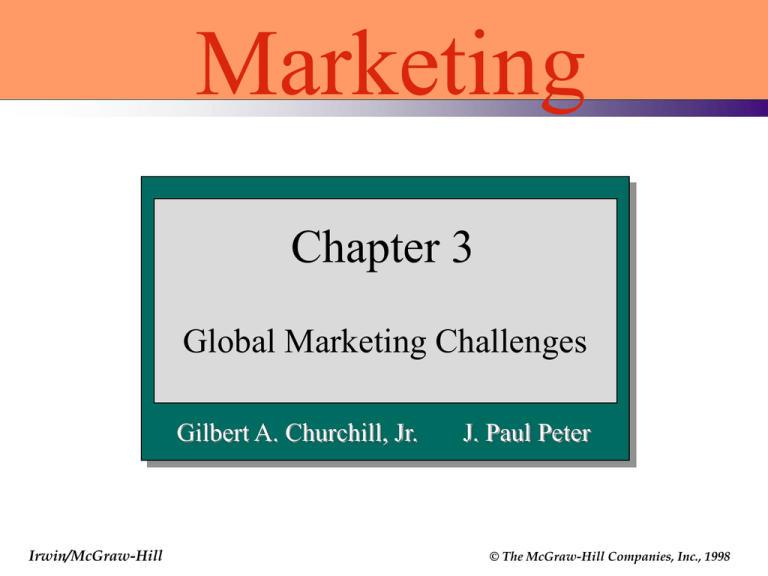
Marketing
Chapter 3
Global Marketing Challenges
Gilbert A. Churchill, Jr.
Irwin/McGraw-Hill
J. Paul Peter
© The McGraw-Hill Companies, Inc., 1998
Slide
3-1
Figure
3.1
A Process for Deciding Whether
to Enter International Markets
Start
No
Must we?
Should we?
Yes
No
Concentrate
Domestically
Yes
Can we?
No
Yes
Identify Specific Opportunities
Select Entry
Option
Source: Betty Jane Punnett and David A. Ricks, International Business
(Boston: PWS-Kent Publishing Co., 1992) p. 257
Improve
Capability
Slide
3-2
Figure
3.2
Major Trading Partners of the U.S.
Imports and Exports in Billions of Dollars
Canada
Exports = $114
Imports = $129
Exports = $53
Exports = $27
U.K.
Imports = $25
Japan
Imports = $119
Exports = $19
Exports = $51
Imports = $32
Imports = $49
Mexico
Source: U.S. Department of Commerce, Statistical Abstract of the United States,
115th ed. (Washington Government Printing Office, 1995) pp. 819-822.
Europe
Slide
3-3a
Table
3.1
Environmental Analysis Issues
in Global Markets
Environment
Economic Environment
Analysis Issues
• Stage of Development
• Buying Power of Consumers
• Type of Currency; exchange rate
Political and Legal Environment
• Political Stability
• Laws limiting international trade
• Laws of host nations
• General Agreement on Tariffs
and Trade (GATT)
Irwin/McGraw-Hill
© The McGraw-Hill Companies, Inc., 1998
Slide
3-3b
Table
3.1
Environmental Analysis Issues
in Global Markets
Environment
Social Environment
Analysis Issues
• Cultural influences on buying
behavior
• Language differences
• Population sizes and distribution
• Socioeconomic status
• Impact on marketing on the culture
• Ethical considerations such as
bribery and human rights
Natural Environment
• Resources available
• Impact of resources on natural resources
Technological Environment
• Levels of technological development
• Available infrastructure
Competitive Environment
• Degrees of government involvement in
competition
• Ownership of competitors-local, foreign
or government
Irwin/McGraw-Hill
© The McGraw-Hill Companies, Inc., 1998
Slide
3-4
Table
3.2
Examples of Cultural Differences that
Could Lead to Marketing Problems
Body Language
Standing with your hands on your hips is a gesture of defiance in
Indonesia.
Physical Contact
Patting a child on the head is a grave offense in Thailand or Singapore
since the head is revered as the location of the soul.
Promptness
In Latin countries, your host or business associate would be surprised if
you arrived at the appointed hour.
Eating and Cooking
It is rude to leave anything on your plate when eating in Norway, Malaysia
or Singapore.
Other Social Customs
In Sweden, nudity and sexual permissiveness are quite all right, but
drinking is really frowned on.
Source: William J. Stanton, Michael J. Etzel and Bruce J. Walker, Fundamentals of Marketing, 9th ed.. (New York: McGraw-Hill,
1991), p. 536. ©1991 by the McGraw-Hill Companies, Inc., and reproduced by permission of the publisher.
Slide
3-5
Exporting
High
Risk
Exporting
Low
Control
High
definition: a mode of entry involving production of a product in one country and
shipping it to another country for sale.
Irwin/McGraw-Hill
© The McGraw-Hill Companies, Inc., 1998
Slide
3-6
Licensing
High
Risk
Licensing
Exporting
Low
Control
High
definition: an agreement in which an organization grants another organization the
right to use a trademark, a patented product or a process.
Irwin/McGraw-Hill
© The McGraw-Hill Companies, Inc., 1998
Slide
3-7
Joint Ventures
High
Joint Ventures
Risk
Licensing
Exporting
Low
Control
High
definition: a business agreement in which two or more organizations share
management of an enterprise.
Irwin/McGraw-Hill
© The McGraw-Hill Companies, Inc., 1998
Slide
3-8
Direct Ownership
High
Direct Ownership
Joint Ventures
Risk
Licensing
Exporting
Low
Control
High
definition: a mode of entry involving an organization setting up new facilities or
acquiring a foreign firm in the same line of business.
Irwin/McGraw-Hill
© The McGraw-Hill Companies, Inc., 1998
Slide
3-9
Table
3.3
Mechanisms for Serving Global
Markets: Some Pros and Cons
Mechanism
Advantages
Disadvantages
May be less profitable than
other mechanisms
Exporting
Simple; minimal financial risk
Licensing
Minimal capital outlay; useful
for serving countries with
export restrictions
Difficult to control licensee; when
licensing agreement ends,
licensee may become a
competitor; may be less
profitable than other mechanisms
Joint Venture
Risk limited to the
organization’s share in the
venture; foreign partner
contributes expertise the
organization lacks; useful
when the host country limits
foreign ownership
Share control with venture
partner; partner may learn
technology or secrets that it
uses to compete with the
organization
Direct
Ownership
Maximum control over foreign
operations; ability to be close
to customers
Expensive to set up; requires
extensive knowledge of foreign
markets and contacts overseas
Source: Based in part on information in Philip R. Cateora, International Marketing, 9th ed. (Burr Ridge, Ill: Irwin, 1996) chapter 10.
Slide
3-10
Globalization vs Customization
Globalized
Product
Irwin/McGraw-Hill
Customized
Product
© The McGraw-Hill Companies, Inc., 1998





